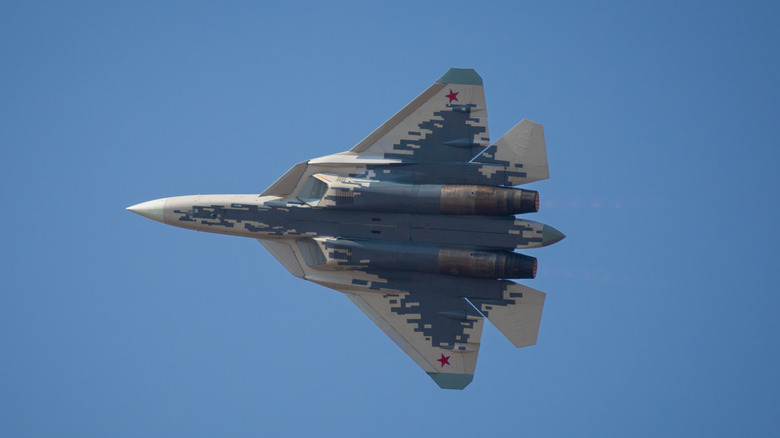What Does 'Su' Stand For On Russian Fighter Jets?
If you've spent any amount of time reading about fighter jets or watching the news coming out of the current wars in Ukraine or Syria, you've likely come across the names of several Soviet-era or otherwise Russian aircraft. MiGs and Tupolevs are fairly common in the sky wherever modern aircraft are fighting. Those aircraft are denoted by the prefixes "MiG" and "Tu," respectively. Another prefix, "Su," pops up occasionally as well. "Su" stands for "Sukhoi," another major Russian aircraft manufacturer.
Sukhoi is named after Pavel Sukhoi, an aircraft designer. The company itself started in 1939, designing aircraft to fight Nazi Germany. The aircraft designed during the Second World War didn't see much action and remain mostly footnotes in Soviet aviation history. However, aircraft produced during the Cold War in the 1950s through the early 1990s became much better known. One such aircraft is the Sukhoi Su-7/Su-22 "Fitter" fighter-bomber, which saw action not only in the Vietnam War, but also Desert Storm and the civil war in Syria under the flag of many different countries, even ones outside the Soviet Union. United States forces have shot down a number of Su-22 jets over the years.
Sukhoi's modern aircraft
Sukhoi also manufactures the Su-27 "Flanker" fighter jet. The Flanker itself has served (and continues to serve) with numerous air forces around the world since it was first flown in the mid-1980s. The Su-27 and its many variants are capable of speeds exceeding Mach 2, and the combined thrust of its two engines totals 55,280 pounds. In the modern era of stealth fighters, Sukhoi designed the Su-57 "Felon," a potential counterpart to the F-22 Raptor and F-35 Lightning II stealth fighters.
The Su-57 is reportedly the Su-27's eventual replacement, according to the United States Army. It's also the first stealth aircraft ever used by Russia. It, too, is capable of Mach 2 speeds and is fitted with not only radar-avoiding technology but also has a 30mm autocannon and a total of eight pylons that allow it to carry air-to-air missiles and bombs. Despite being a stealth aircraft, the U.S. Army notes that "the seams between parts, and rivets are much less optimized for radar stealth compared to the F-22." The F-22 and Su-57 have not faced each other in combat as of yet, so the claim has not been tested.

